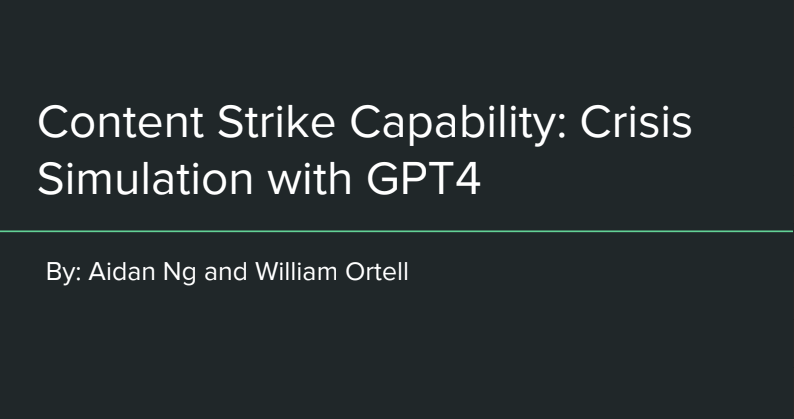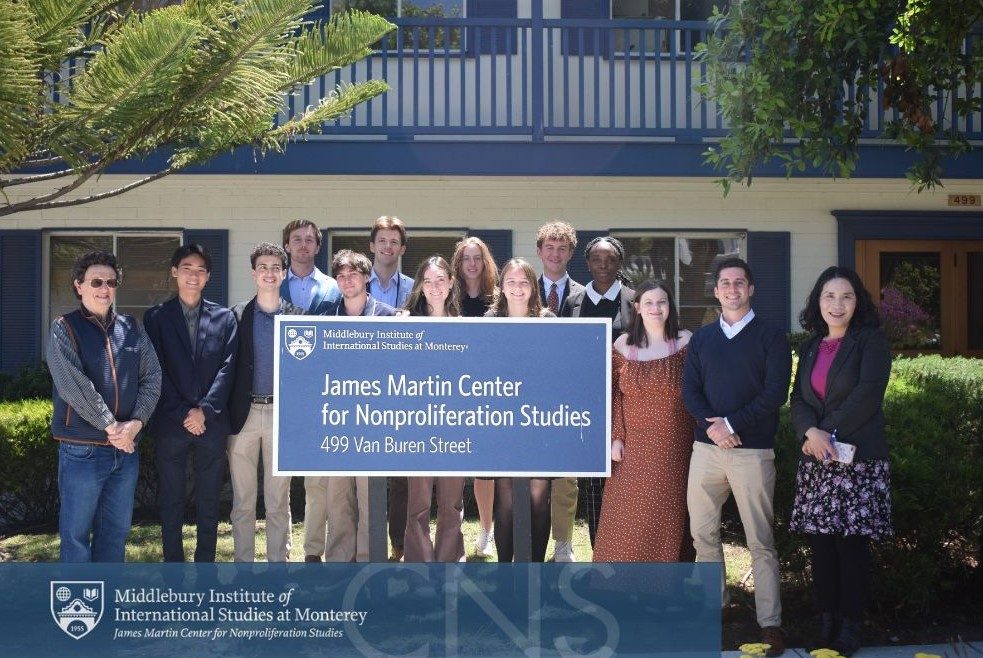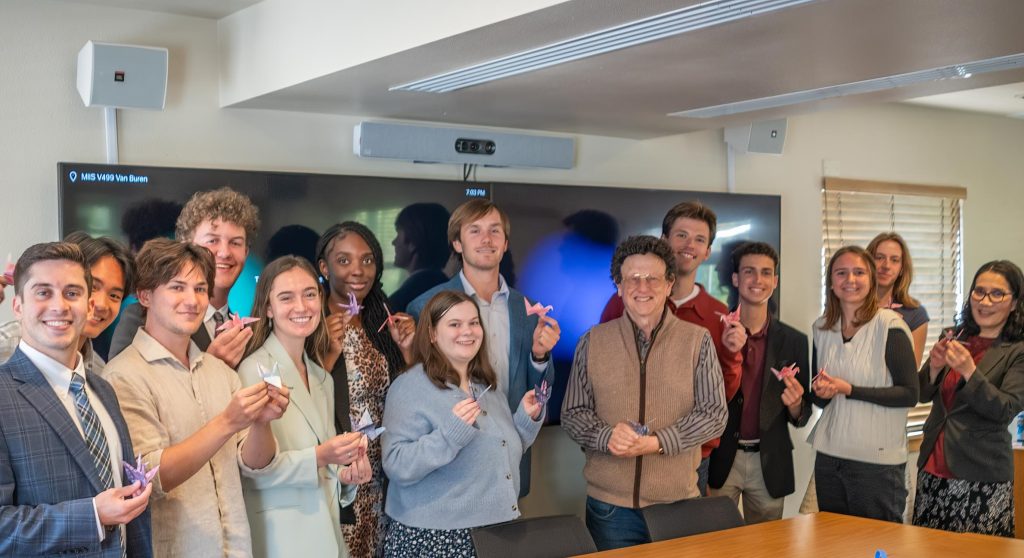
Please find below the slides of final presentations CNS Summer Undergraduate Fellows prepared within their individual research projects.
Russian Academics’ Nuclear Opinions: The Debate Around “Limited” Nuclear Use
by Emma Scherer, Middlebury College, International and Global Studies
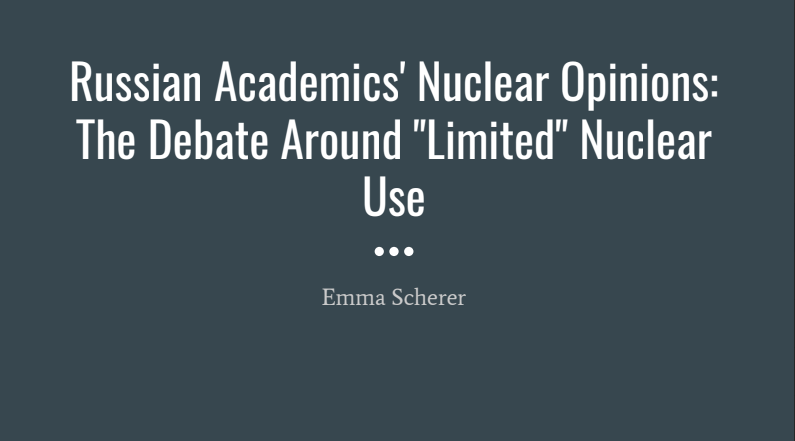
Recently several influential Russian academics have published articles bringing up the issue of “limited” preemptive nuclear use in the context of the war in Ukraine. Karaganov uses the metaphor of a “ladder of escalation,” which he advocates the quick climbing of to effectively deter the “collective west,” after which “Russia and humanity will set off through the thorns and trauma to the future.” These statements are disturbing primarily not necessarily because they suggest imminent nuclear use, but rather because they reflect a growing tolerance in the Russian academic community towards the idea of “limited” nuclear use. My research will directly address this trend, analyzing spread and proposing its possible origins.
Nuclear Blackmail: Russian VVER Reactors and the ZNPP
by Ben Cordola, Middlebury College, Geography & Russian

Between 2012 and 2021 Russia’s state nuclear energy company, ROSATOM, began construction of 19 VVER-type nuclear reactors; 15 of these initiated abroad. The largest nuclear power plant in Europe, Zaporizhzhia Nuclear Power Plant (ZNPP), is made up of 6 VVER reactors and has been under Russian control since a few weeks into the full-scale invasion of Ukraine. A discussion on the use of these reactors as exports of both influence and economic dependency abroad is an interesting one, and on a smaller scale, the case of the ZNPP is a fascinating crossroads between both environmental threats and the military use of peaceful nuclear infrastructure in wartime. I will focus on the ZNPP as a case study and highlight the utility of “new tools” for monitoring from afar.
The Domestic Aspect of Foreign Affairs: Exploring the Intersection of Iranian Politics and Nuclear Negotiations
by Jonathan Rosenberg, Princeton University, Near Eastern Studies
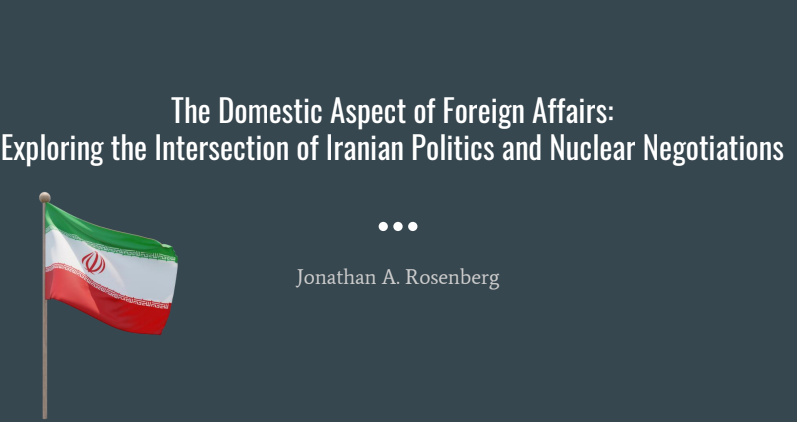
Though many scholars have explored the history of Iran’s nuclear diplomacy, and others have conducted research on Iran’s domestic politics, these two fields have rarely been combined in the scholarly literature. An important question has by-and-large remained unanswered: how have Iran’s elected officials (i.e., its presidents and members of Parliament) shaped the country’s nuclear negotiations? Within the American media, Iranian elections are either decried as insignificant due to Khamenei’s strong authority, or they are regarded as key to shaping Iran’s new nuclear direction. I will explore which attitude is closer to the truth, and upon reaching my conclusion, I will extrapolate my findings to discuss how the United States should react to future Iranian elections to maximize beneficial outcomes from nuclear negotiations with Iran.
Rocking the Boat: The Potentially Destabilizing Role of Sea-Based Nuclear Weapons in South Asia
by Luke Caggiano, University of Georgia, International Affairs

Though traditionally viewed as a stabilizing factor in nuclear deterrence, the development and deployment of sea-based nuclear weapons in South Asia may prove disastrous for crisis stability in the region. Focusing on India’s pursuit of nuclear-powered ballistic missile submarines and Pakistan’s deployment of nuclear armed submarine-launched cruise missiles, this project analyzes how both countries’ nuclear posturing and command, and control may be negatively affected by the introduction of sea-based nuclear weapons. Having established the dangers these weapons present to the region; this project outlines some potential steps forward that may mitigate crisis escalation to the nuclear level.
Nuclear Energy Programs in the Middle East: Proliferation and Policy Implications
by Annie Street, University of Southern California, International Relations & Environmental Studies

In the context of nuclear energy development, a problematic dichotomy exists in the Middle East. The region is one of the most adversely affected by climate change, as well as one of the most conflict-ridden regions in the world. Many Middle Eastern states have a strong interest in developing nuclear energy as a means of building long-term resilience to environmental degradation, but regional instability paired with Israel’s policy of nuclear opacity and Iran’s extensive enrichment capabilities have raised concerns that nuclear energy development in the Middle East could quickly escalate into extensive proliferation of nuclear weapons. In this project, I investigate the Middle East’s 1) environmental motivations for nuclear energy, 2) involvement and compliance with the nonproliferation regime, and 3) political motivations and deterrents for weapons proliferation to evaluate how realistic the fear really is that expanding nuclear energy capabilities in the Middle East will result in weapons proliferation. By the conclusion of my project, I hope to have developed a clear set of policy recommendations that can reduce whatever tangible proliferation risks emerge as more Middle Eastern states develop nuclear energy programs.
Preventing Proliferation Caused by Great Power Competition in Africa: Assessing Historical Examples and Modern Challenge
by Sean Manning, University of Georgia, International Affairs & Economics
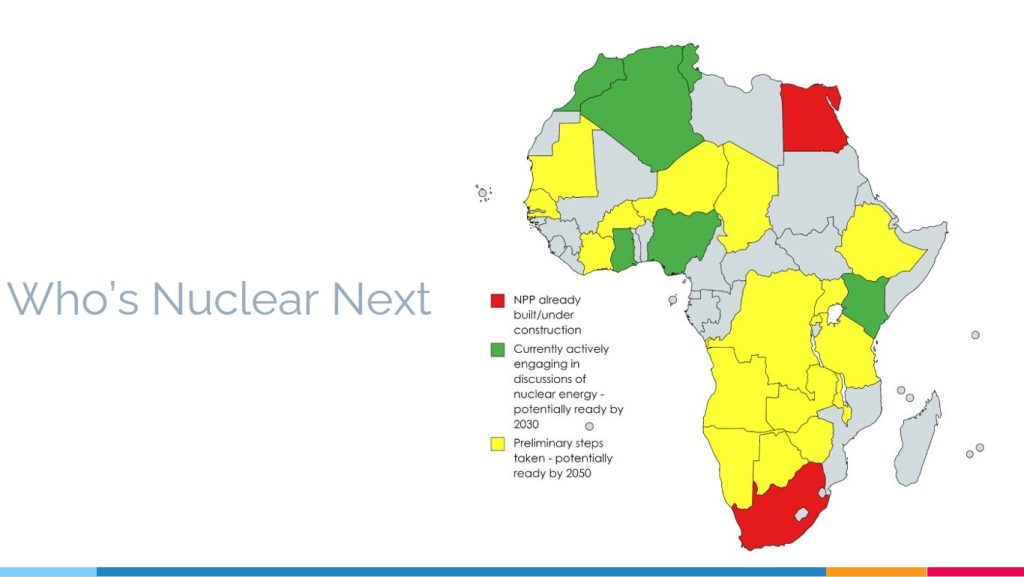
Africa is a continent on the rise. Increasing production, population, and prosperity make Africa a new venue for great power competition. I plan to research the past pressures on developing nations that cause them to reach for proliferation as a means of self-protection when caught in the middle of great power competition. On the African continent itself, South Africa provides a ripe historical example of how great powers can sow instability and propagate proliferation. Moving on from the unique example of South Africa, I will examine the budding nuclear power plant industry in Africa and how bidding for nuclear contracts has turned into a proxy great power competition. Then, I will analyze potential future risks of proliferation and find mitigation steps for those risks to be taken now. By encouraging regional actors to build proliferation guardrails in Africa while nuclear energy is still nascent, many risks of proliferation in the long term can be prevented.
The Treaty on the Prohibition of Nuclear Weapons (TPNW): From an International Human Rights Law Perspective
by Funmi Ayodeji, Trinity Washington University
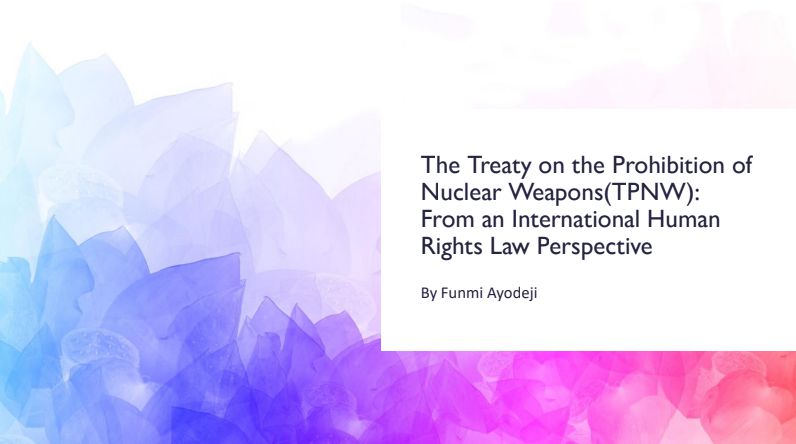
The Treaty on the Prohibition of Nuclear Weapons which entered into force on January 22, 2021, is the first complete universal ban on nuclear weapons. It is an important part of international law because it attempts to set a norm that nuclear weapons are unacceptable. By focusing on the humanitarian impact of the use of nuclear weapons, the treaty presents a shift from state security toward human-centered security. This research explores the human rights law aspect of the TPNW and other types of international law that address victims of nuclear weapons use/testing. My research project will argue that the treaty represents a bridge between nuclear disarmament and human rights. Investigating this relationship is important because it sheds light on the humanitarian aspect of disarmament and on how human rights movements can connect with nuclear disarmament movements and discussions.
How the Bomb Was Made: Tracking the Ecological Impacts of the Creation of the W80-1
by Tessa Marker, Middlebury College, International Politics and Economics

This project will examine the environmental and humanitarian side effects of the creation of the W80 mod 1, a two-stage thermonuclear bomb which began development in by the Los Alamos National Laboratory in 1976. To understand the magnitude of the side effects of the development of this bomb, I will look at the locations where uranium was mined, milled and enriched, where plutonium was produced, where these materials were assembled into a weapon and where they were tested. My goal is to create a map alongside my presentation that tracks the locations/possible locations where resources were extracted to make the W80.
The Influence of US Export Controls on Nuclear Energy Prospects in Southeast Asia
by Aidan Ng, Georgetown University, International Politics
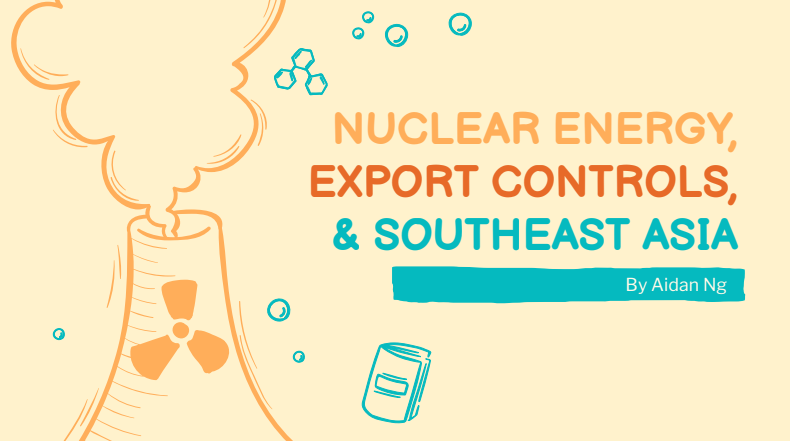
This project will examine the role of US export controls in facilitating or disabling the shift toward nuclear energy in Southeast Asia. The presentation will begin with a historical analysis of ASEAN state’s capabilities and attempts to nuclearize, and how those efforts tie into their present actions. Next, the presentation will attempt to predict when each ASEAN state is likely to shift towards nuclear energy, and what that process may look like. Finally, the presentation will examine how the US can use export controls (or lack of export controls) to protect its interests in the region amid a nuclear transition.
The Evolution of Chinese Export Controls: Past, Present, and Future Challenges
by Ashley Morford, Indiana University, International Studies, Political Science & Eastern European Languages and Cultures

Since China’s detonation of an atomic weapon in 1964, the international community has feared its potential to proliferate nuclear material, knowledge, and delivery systems to its partners. This fear was due in no small part to its lack of a public export control framework until 1996. This presentation will explore the evolution of China’s views and policies towards export controls, evaluate their effectiveness, and discuss potential developments in these areas as China increasingly seeks to exert its influence as a global leader.
Asymmetric Implementation: Implications of AI Governance for Nuclear Competition
by William Ortell, University of Southern California, International Relations

This presentation seeks to investigate the following question: how might AI governance measures impact nuclear weapons competition and alter international coordination? I begin by outlining the current artificial intelligence landscape and reviewing recent policies and policy proposals that have been proposed to regulate the most cutting-edge models. I then examine current and future uses of AI/machine learning (ML) technologies in nuclear weapons systems. Using these bodies of research, I analyze prospects for future international coordination on nuclear weapons systems, concluding that AI governance measures are likely to reinforce current technological asymmetries, lower confidence in strategic stability, and heighten nuclear competition.
Diverse Applications of Open-Source Technology in the Field of Nuclear Security, Arms control, and Intelligence
by Daniel Allen, Middlebury College, Political Science & Cultural Anthropology

Showing how OSINT techniques can be used on a variety of nuclear issues and arms control issues. I will be doing this by showing off three separate case studies I did in my time here. One, examining an abandoned uranium mine for signs of artisanal harvesting and smuggling. Two, quantitative models of the newest Iranian missiles. Three, investigating nuclear storage facilities in Belarus.
Content Strike Capability: Crisis Simulation with GPT4
by Aidan Ng, Georgetown University & William Ortell, University of Southern California
